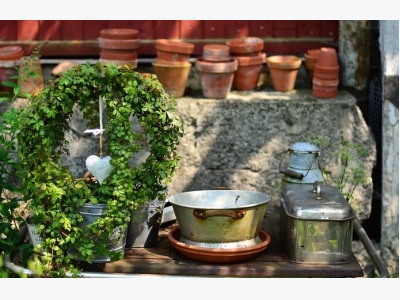Secrets of Successful Container Gardening

Have you ever put together a really beautiful container garden, only to see some plants turn sickly and die after just a week or so?
Or have you ever seen a beautiful container garden, and thought, "I wish I could do that"? Either way, this article is for you. We're going to explore the secrets of successful container gardening, as well as a few tips and tricks for making your container garden beautiful and interesting.
Selecting Container Plants
The first thing to keep in mind when starting a container garden is not all plants like the same sun, soil, and water conditions. Rosemary, for example, likes it hot and sunny and dry, with soil on the coarse and sandy side. So do ice plant, oregano, and thyme. These you don't water until the top of the soil is actually dry.
But suppose you decided to pair a creeping rosemary or ice plant with an upright fern. That would look good; the low growth of the one complements the upright habits of the other. Why wouldn't this scenario work?
Well, because the fern is a forest-dwelling plant. It stays cool and shady at the feet of massive oaks, where leaf mold lies like mulch over loam, keeping its roots damp and nourished. Put a fern and a rosemary plant together, and either the fern will die from lack of water, lack of nutrients, and too much heat and sun, or else the rosemary will die from root rot (from too much water), not enough heat, and not enough sun.
Either way, it's a no-win situation. And if you try to balance their needs—you end up with both of them turning sick and dying on you!
So how do you avoid that problem? Well, an intimate knowledge of the likes and dislikes of each plant is always a good start. But barring that, look at the tags that come with the plants when you purchase them. If you didn't purchase the plant, or for some reason it doesn't have a tag, go online and type its name into a search engine. You should be able to find all the information you need.
The care tags should tell you everything you need to know about the plant, its height, its growth habits (sprawling/creeping, vining, bushy, or upright) and its sun, soil, and water requirements. Choose plants that will grow together happily. Remember, sun, soil, and water are the most important.
Contrast Tips for Container Gardens
Once you've narrowed you choices down to plants that can actually live together, it's time to look at that all-important design process. Generally in a container garden you want contrasts. Tall, upright plants contrasted with low creeping ones; broad, flat leaves contrasted with tiny round ones; plants grown for their flowers contrasted with plants grown for their foliage.
What you don't want to contrast, however, is color. The colors should work well together. Now, I'm not advocating ditching the blues and the purples, because in the right setting, blue and purple can go quite well together. But in general, try to stick to different color families; earth tones, brights, neons, or pastels, for example.
Dusty Miller's silvery foliage is a perfect complement to an upright gray-green rosemary. Both colors are set off by a border of dark green mother-of-thyme, and the tiny pastel pink flowers on the mother-of-thyme complement (rather than contrast) the tiny lavender flowers on the rosemary.
Such a container garden would be subtle, elegant, understated. It would go best in a soft gray marble container (or in a plastic container made to look like gray marble). Now imagine the same container garden, this time with splotches of bright pink petunias in it. Ludicrous, isn't it?
Alternately, imagine a ring of bright pink or purple petunias around the edge of pot hidden inside a white wicker basket. A few sprays of bright pink Blazing Star spring up from the center, with ice plant draping over the sides. The entire tableau is vibrant, alive, colorful. Now imagine adding a few delicate Quaker Ladies to it. They'd be lost, swamped by the color and the size of the blossoms around them.
Remember, you want contrast, not clashing. When you go to garden centers, gather up the plants that you think will look good together. Arrange them as they'll be arranged in your container. Build your little group one plant at a time, taking this out or adding that in, depending on what you find most pleasing to the eye.
And remember: always, always check the sun, soil, and water requirements for each plant before you stick them together.
Related news
 How to Grow a Prayer Plant
How to Grow a Prayer Plant With beautiful foliage and easy maintenance, the prayer plant (Marantaceae) is a lovely exotic house plant to enjoy indoors.
 How to Grow Angelonia
How to Grow Angelonia Angelonia is a cheerful little snapdragon flower for your landscape or containers. It comes in a variety of colors in shades ranging from whites and pinks
 How to Grow the Eastern Wahoo Shrub
How to Grow the Eastern Wahoo Shrub Flaming fall foliage and an attractive multi-stemmed form make Burning Bush a popular choice for a hedge or shrub planting.